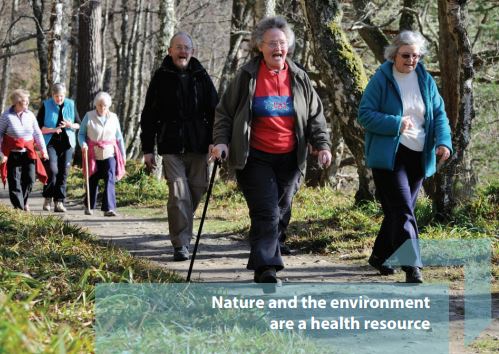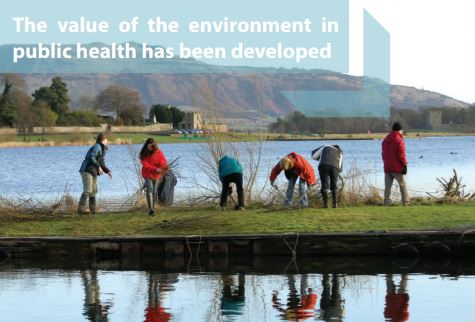Case Study
Promoting ‘Green Health’ in Scotland
Contact name
Steffi Burger
Institution name
EUROPARC Federation
Region & country
Scotland (UK)
Summary
Scotland has a poor record when it comes to public health, but in recent years has developed a policy framework embracing the natural environment and the health sector in order to change the status quo. The Green Exercise Partnership brings together a range of actors so that a Natural Health Service can complement the National Health Service. Nature and the environment are increasingly promoted as a health resource and progress in a number of health indicators is being made.


Background of the project
Scotland’s health record is poor, often being described as the sick man of Europe, but over recent years a strong policy framework which recognises the value of the environment in public health has been developed. The Scottish Government’s key mechanism to steer and monitor delivery of its outcomes-based approach is its National Performance Framework. This has established five Strategic Objectives e.g. a Healthier Scotland; a Greener Scotland, and a set of National Outcomes which guide central and local government planning. National Performance Indicators are used to monitor performance, and for delivering a Healthier Scotland, indicators include: Increase people’s use of Scotland’s outdoors; Increase physical activity and Increase the proportion of journeys to work made by public or active transport.
It’s important to stimulate broad recognition of the value of the environment as a health promoting resource.
Solution and actions taken
Supporting this top-level objective, there are a range of Government, Agency and NGO policies which build on the growing evidence base regarding the physical and mental health benefits of being active in the outdoors – for example, Scottish Natural Heritage’s statement on Health & the Natural Heritage.
Besides, the Green Exercise Partnership (GEP) in Scotland brings environmental organisations Scottish Natural Heritage and Forestry Commission Scotland together with the national health promotion organisation NHS Health Scotland.
Scotland has a stunning environment, progressive access legislation and a wide range of assets including national and local nature reserves, and path networks which provide access close to where people live. The GEP works to raise the profile and develop better understanding of how to use these assets for public health benefits by: influencing health policy and government strategy; making briefing material available to politicians and policy-makers, and producing online resources including case studies for practitioners.
- The Green Exercise Partnership (GEP) in Scotland brings environmental organisations Scottish Natural Heritage and Forestry Commission Scotland together with the national health promotion organisation NHS Health Scotland. GEP’s supports turning policy into practice by helping make Green Health a key element of the Government’s wider physical activity agenda.
- A key work stream for the GEP is working with the National Health Service to make use of environmental assets surrounding healthcare settings as a health-promoting resource.
- Landscape and access improvements bring a range of health benefits, as well as enhancing biodiversity and delivering more cost-effective estate management systems.
- Urban parks and green corridors; woodlands and greenspace around settlements; path networks; National Parks and other Protected Areas managed by the public, voluntary or private sectors, can all contribute to healthier lifestyles and improved quality of life.
- At some sites, information about other green exercise assets such as local paths or Health Walk Groups is being collected so that health practitioners can promote nearby opportunities to their patients.
- In contributing the Health agenda, Scottish Natural Heritage has adopted a broad definition of health-promoting natural assets, and is championing the role of a Natural Health Service to help tackle poor health and health inequalities.
Other institutions or parties involved
Results
- Linking the Environment and Health sectors through establishment of a Green Exercise Partnership and turning policy into practice.
- Increased profile of the benefits of Green exercise in the Health and Environment sectors
- Demonstration project had started in 2010 showing how to maximise the health-promoting potential of environmental assets surrounding healthcare settings and thus has enabled the green space around a number of hospital sites to be developed for therapeutic purposes for patients, and for physical activity and relaxation for staff, visitors and neighbouring community.
- The experience Scottish Natural Heritage has developed through its work on Green Health is being fed into a Europarc Federation Working Group on Health & Protected Areas as well as in an IUCN task force on best practice guidelines on Healthy Parks Healthy People.
Challenges
Progress is being made in Scotland, but there are still challenges – for example achieving cross-sector co-ordination; and the size and complexity of the health service and the time required to embed new initiatives.
Lessons learned
- A robust policy context for connecting public health & the natural environment is important, helping to increase cross-sector understanding and make the case for resources.
- Maximising health benefits means looking beyond Protected Areas and helping people to connect with nature as a part of their daily lives. However, Protected Areas also have their part to play.
- Local partnership working between health and environment sectors can help to link people and place.
- Both sectors should be encouraged to share their examples of good practice.
Other resources
-
National Performance Framework
http://www.scotland.gov.uk/About/Performance/scotPerforms
Contact name
Steffi Burger
Institution name
EUROPARC Federation